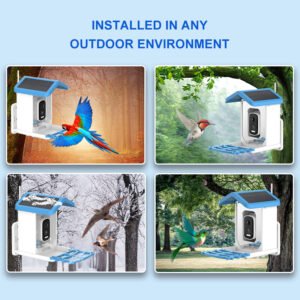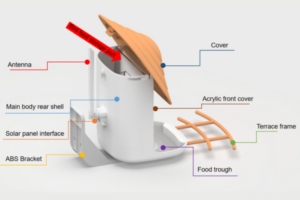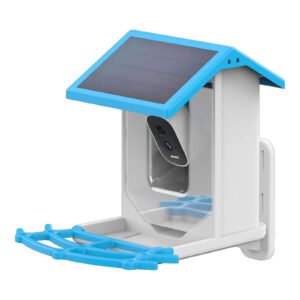Struggling to attract birds to your new feeder? Without the right setup, birds may ignore it, leaving your feeder empty. Don’t worry—this guide will provide practical steps to solve the problem and bring birds flocking to your feeder.
Want to attract birds to your feeder? Start by choosing the right location, offering the right food, and maintaining a clean, welcoming environment. Learn more in this guide!
Ready to dive deeper into attracting more birds to your feeder? Keep reading for expert tips!
How Do You Get Birds to Come to Your Bird Feeder?
The first step is offering a variety of foods that appeal to different types of birds. Seeds such as sunflower, safflower, and millet are popular among many species. You can also add suet or fruit to attract different birds. Placement is crucial—make sure your feeder is in a quiet, sheltered area to make birds feel safe. Keeping your feeder clean and consistently replenishing the food will encourage birds to visit regularly.
How Long Will It Take for Birds to Find a New Feeder?
It can take anywhere from a few days to a few weeks for birds to find a new feeder. The time depends on location, food offerings, and surrounding natural food sources. To speed up the process, try placing the feeder in an area where birds are already accustomed to finding food. Be patient, and ensure the feeder is visible from a distance.
Why Am I Not Getting Birds at My Bird Feeder?
If birds aren’t visiting your feeder, it could be due to several factors. It may be in a location that’s too exposed, or the food might not be appealing to the local bird population. Ensure your feeder is in a safe, quiet area, and try using different types of food or adding fresh water. It could also be that the feeder is too close to predators, such as cats or squirrels.
Do Birds Tell Each Other Where Food Is?
Yes, birds often communicate the location of food sources through calls and visual cues. For example, a bird that finds a good food source may alert others by calling out or signaling. Once one bird has discovered the feeder, it’s likely others will follow, especially if the food is abundant.
Where Is the Best Place to Put a Bird Feeder?
The best place to put a bird feeder is in a quiet, sheltered area. Ideally, it should be away from predators, such as cats or squirrels, and near trees or shrubs where birds can perch and feel safe. A balcony or window feeder works well if you want to get a close-up view of the birds. For a balcony, choose a location that offers visibility and protection from strong winds.
How to Draw Birds to a New Feeder?
To attract birds to a new feeder, make sure to place it in a location that birds already frequent. Offer a variety of seeds or suet to cater to different species. You can also use a birdbath nearby to attract birds looking for water. Consistency is key—refill the feeder regularly to encourage birds to return.
Why Am I Seeing Fewer Birds at My Feeder?
Fewer birds could be due to seasonal changes, food supply, or external factors like weather or predators. During winter, birds may visit feeders less frequently, but they still need food and water. You may also need to clean your feeder regularly to prevent mold or bacteria, which could discourage birds.
Do Birds Like Feeders High or Low?
Most birds prefer feeders that are placed at a moderate height, allowing them to feel secure from predators. Feeders placed at eye level or slightly above the ground are ideal for attracting a wide range of species. However, some birds, like hummingbirds, prefer feeders placed lower, where they can easily access nectar.
What Time Are Birds Most Active at Feeders?
Birds are generally most active at dawn and dusk, when they are looking for food. Early morning is often the best time to catch birds visiting your feeder, as they search for breakfast before heading to their nests. Be sure to replenish the food supply before these peak times to attract more birds.
What Color Bird Feeder Attracts More Birds?
Bright colors like red, yellow, and orange tend to attract more birds, particularly hummingbirds. These colors mimic the flowers and fruits that many birds naturally seek. For a more general appeal, neutral colors like green or brown work well for larger bird species like finches or sparrows.
Should Bird Feeders Be in the Sun or Shade?
Bird feeders should ideally be placed in partial shade. Too much direct sun can cause the food to spoil quickly, while too much shade might make it harder for birds to spot the feeder. A spot with morning sun and afternoon shade is often ideal, as it keeps the food fresh and visible.
How Do You Make an Attractive Bird Feeder?
An attractive bird feeder combines functionality with aesthetic appeal. Choose a design that blends well with your garden or balcony, such as a rustic wooden feeder or a colorful, modern feeder. Ensure the feeder is easy to clean, has drainage holes, and is spacious enough for birds to comfortably feed.
What Direction Should a Bird Feeder Face?
It’s best to face your bird feeder towards the prevailing wind direction or towards a more sheltered side of your garden or balcony. This will help protect the birds from strong gusts of wind and make the feeder more comfortable for feeding.
What Bird Feeder Attracts the Most Birds?
Tube feeders, platform feeders, and suet cages tend to attract the most birds. Tube feeders are especially good for small songbirds, while platform feeders can accommodate a wider variety of species. Suet feeders attract woodpeckers and other insect-eating birds.
Summary
Attracting birds to your feeder requires the right food, placement, and patience. Follow these steps, and you’ll soon be enjoying the sight of a wide variety of birds visiting your feeder






